Annual Energy Consumption Cut-Off with Cooling System Design Parameter Changes in Large Office Buildings
Abstract
1. Introduction
1.1. Background of the Study
1.2. Research Trend and Objectives
2. Study Overview
2.1. Study Scope and Methodology
2.2. Overview of the Target Building and Design Elements of HVAC&R
3. Energy Usage Analysis Using Simulations
3.1. Analysis of Cooling Energy Consumption According to Hydronic System Type
3.2. Analysis of Energy Consumption according to Chilled Water Production Temperature and Temperature Difference
3.3. Energy Consumption Analysis with Changes in Normal Design of Cooling Tower System
3.4. Analysis of Annual Cooling Energy Consumption in Whole Cooling Heat Source Systems
4. Conclusions
Author Contributions
Funding
Conflicts of Interest
References
- Masson-Delmotte, V.; Zhai, P.; Pörtner, H.; Roberts, D.; Skea, J.; Shukla, P.R.; Pirani, A.; Moufouma-Okia, W.; Péan, C.; Pidcock, R.; et al. Global Warning of 1.5 ℃ Summary for Policymakers Technical Summary; Intergovernmental Panel on Climate Change (IPCC): Geneva, Switzerland, 2018. [Google Scholar]
- Ministry of Environment (ME). The Revised 2030 National GHG Reduction Roadmap; ME: Sejong, Korea, 2018. [Google Scholar]
- Ministry of Trade, Industry and Energy (MOTIE). 2017 Energy Consumption Survey; MOTIE: Sejong, Korea, 2018. [Google Scholar]
- Wang, S. Intelligent Buildings and Building Automation; Spon Press (Taylor & Francis): London, UK; New York, NY, USA, 2010. [Google Scholar]
- Kirsner, W. The demise of the Primary-Secondary Pumping Paradigm for Chilled Water Plant Design. HPAC Eng. 1996, 68, 73–78. [Google Scholar]
- Wang, S.; Ma, Z.; Gao, D. Performance enhancement of a complex chilled water system using a check valve: Experimental validation. Appl. Therm. Eng. 2010, 30, 2827–2832. [Google Scholar] [CrossRef]
- Rhee, K.N.; Yeo, M.S.; Kim, K.W. Evaluation of the control performance of hydronic radiant heating systems based on the emulation using hardware-in-the-loop simulation. Build. Environ. 2011, 46, 2012–2022. [Google Scholar] [CrossRef]
- Seo, B.M. Comparison of Cooling Energy Performance Between Conventional AHU System and DX AHU-Water Source VRF Heat Pump System in an Office Building. Master’s Thesis, Hanbat National University, Daejeon, Korea, 2017. [Google Scholar]
- Kim, S.H.; Kim, D.G. A Survey Study on Optimal Cooling Equipment Capacity in Office Buildings. J. Archit. Inst. Korea Plan. Des. 2007, 23, 247–254. [Google Scholar]
- Jung, J.R.; Kim, S.H.; Lee, K.H. A study on the Application of Safety Factors for optimal Sizing, of Central Plant Equipment. J. Archit. Inst. Korea Plan. Des. 2000, 16, 77–84. [Google Scholar]
- Gang, W.; Wang, S.; Shan, K.; Gao, D. Impacts of cooling load calculation uncertainties on the design optimization of building cooling systems. Energy Build. 2015, 94, 1–9. [Google Scholar] [CrossRef]
- Korean Standards Association (KSA). Centrifugal Water Chillers; KS B 6270: 2015; KSA: Seoul, Korea, 2015. [Google Scholar]
- Korean Standards Association (KSA). Performance Tests of Mechanical Draft Cooling Tower; KS B 6364: 2014; KSA: Seoul, Korea, 2014. [Google Scholar]
- Takahashi, T. Understanding and Application of HVAC Control in Buildings; Sejinbook: Seoul, Korea, 2012. [Google Scholar]
- Taylor, S.T. Primary-Only vs. Primary-Secondary Variable Flow Systems. ASHRAE J. 2002, 44, 25–29. [Google Scholar]
- Shin, D.S.; Park, S.B.; Jun, T.I.; Ma, K.I.; Kim, T.H.; Lee, S.G. Energy Consumption Evaluation in Pumping System with Different Building Characteristics. Korean J. Air-Cond. Refrig. Eng. 2016, 28, 242–247. [Google Scholar] [CrossRef][Green Version]
- Kim, S.H.; Kwak, R.Y. Evaluation of Energy Savings Applying Energy Efficient Control of Variable Speed Pump in HVAC Hydronic Systems. J. Archit. Inst. Korea Plan. Des. 2012, 28, 207–214. [Google Scholar]
- Ahn, B.C. The Effects of Operational Conditions of Cooling Water System on Energy Consumption for Central Cooling System. Trans. Korea Soc. Geotherm. Energy Eng. 2017, 13, 8–13. [Google Scholar]
- Kwak, Y.H.; Kong, D.S.; Cheon, S.H.; Kwak, R.Y.; Huh, J.H. Analysis of Energy Potential Savings by a condensing water temperature control through EMS Simulation. In Proceedings of the SAREK 2011 Summer Conference, Pyeongchang, Korea, 6–8 July 2011. [Google Scholar]
- Lee, J.H.; Kim, H.M.; Song, Y.H. A Study on verification of changes in performance of a water-cooled VRF system with control change based on measuring data. Energy Build. 2018, 158, 712–720. [Google Scholar] [CrossRef]
- American Society of Heating, Refrigerating and Air-conditioning Engineers (ASHRAE). Energy Standard for Buildings Except Low-Rise Residential Buildings; ASHRAE Standard 90.1; ASHRAE: Atlanta, GA, USA, 2013. [Google Scholar]
- Passive House Institute Korea (PHIKO). Available online: https://climate.onebuilding.org/ (accessed on 1 February 2020).
- Ministry of Land, Infrastructure and Transport (MOLIT). Building Energy Saving Design Standards; MOLIT: Sejong, Korea, 2018. [Google Scholar]
- American Society of Heating, Refrigerating and Air-conditioning Engineers (ASHRAE). Ventilation for Acceptable Indoor Air Quality; ASHRAE Standard 62.1; ASHRAE: Atlanta, GA, USA, 2007. [Google Scholar]
- The U.S. Department of Energy. EnergyPlus Engineering Reference. Available online: https://energyplus.net/sites/all/modules/custom/nrel_custom/pdfs/pdfs_v8.9.0/EngineeringReference.pdf (accessed on 19 April 2020).
- American Society of Heating, Refrigerating and Air-conditioning Engineers (ASHRAE). ASHRAE Handbook Fundamentals; ASHRAE: Atlanta, GA, USA, 2017. [Google Scholar]
- Taylor, S.T. Degrading Chilled Water Plant Delta-T: Causes and Mitigation. ASHRAE Trans. 2001, 108, 641–653. [Google Scholar]
- American Society of Heating, Refrigerating and Air-conditioning Engineers (ASHRAE). ASHRAE Handbook HVAC Systems and Equipment; ASHRAE: Atlanta, GA, USA, 2016. [Google Scholar]
- Taylor, S.T. Optimizing Design & Control of Chilled Water Plants Part 3: Pipe Sizing and Optimizing △T. ASHRAE J. 2011, 53, 22–35. [Google Scholar]
- American Society of Heating, Refrigerating and Air-conditioning Engineers (ASHRAE). ASHRAE Green Guide: The Design, Construction, and Operation of Sustainable Buildings, 3rd ed.; ASHRAE: Atlanta, GA, USA, 2010. [Google Scholar]
- Ha, J.W.; Park, K.S.; Kim, H.Y.; Song, Y.H. A Study on Annual Cooling Energy Consumption Cut-off with Cooling Tower Control Change. J. KIAEBS 2019, 13, 503–514. [Google Scholar]
- Takahashi, T. Building Energy and HVAC Control; Sejinbook: Seoul, Korea, 2012. [Google Scholar]
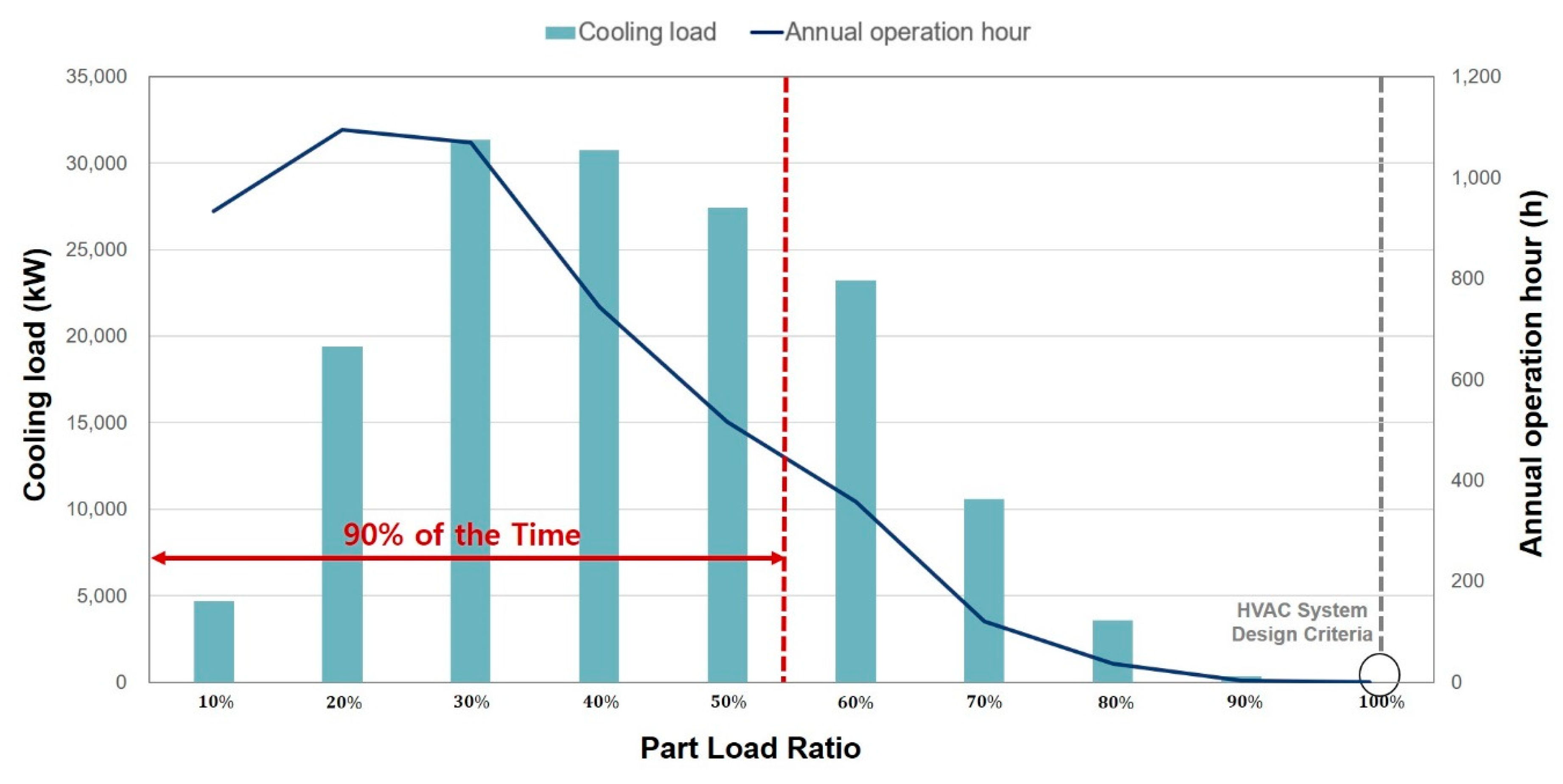
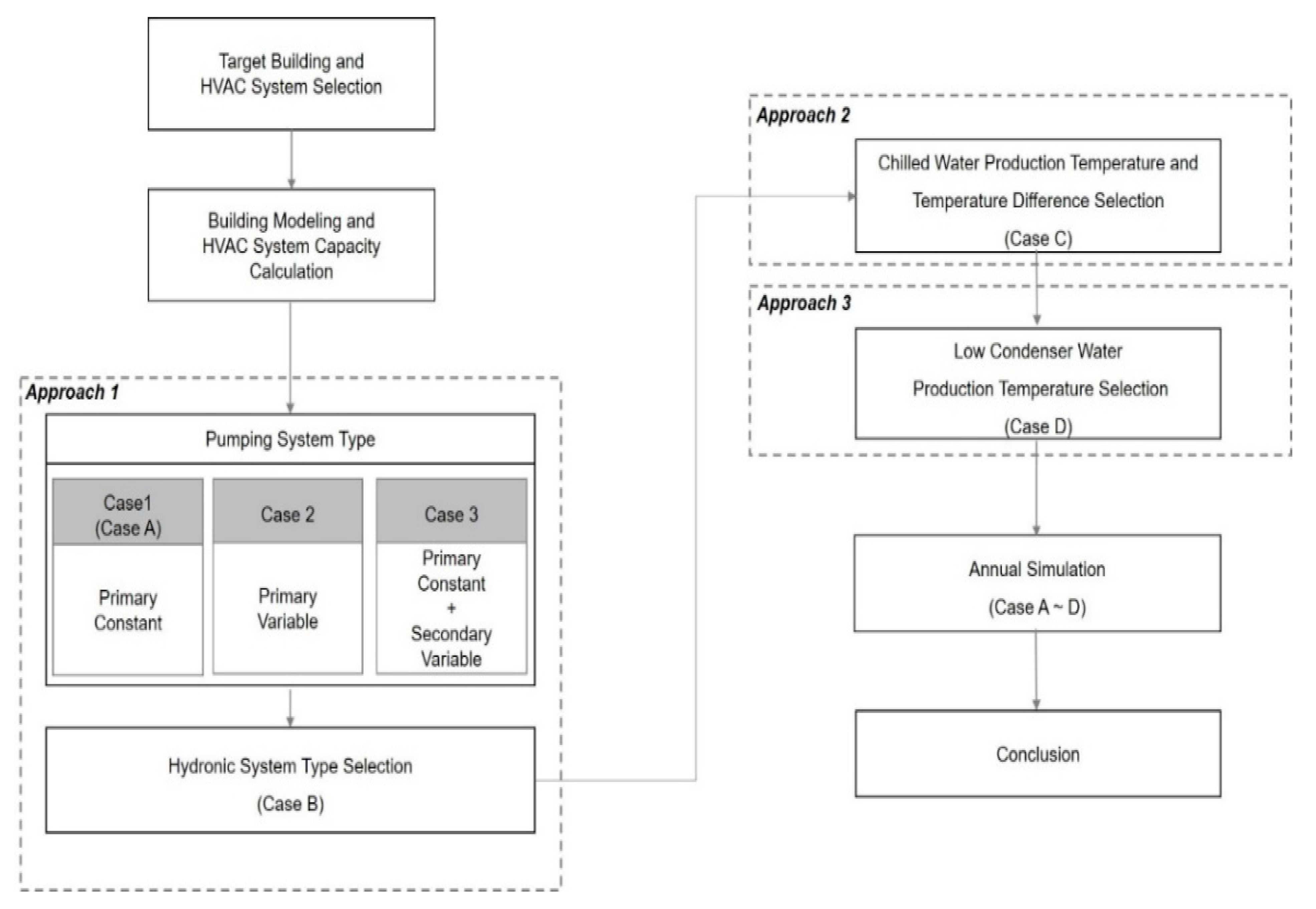
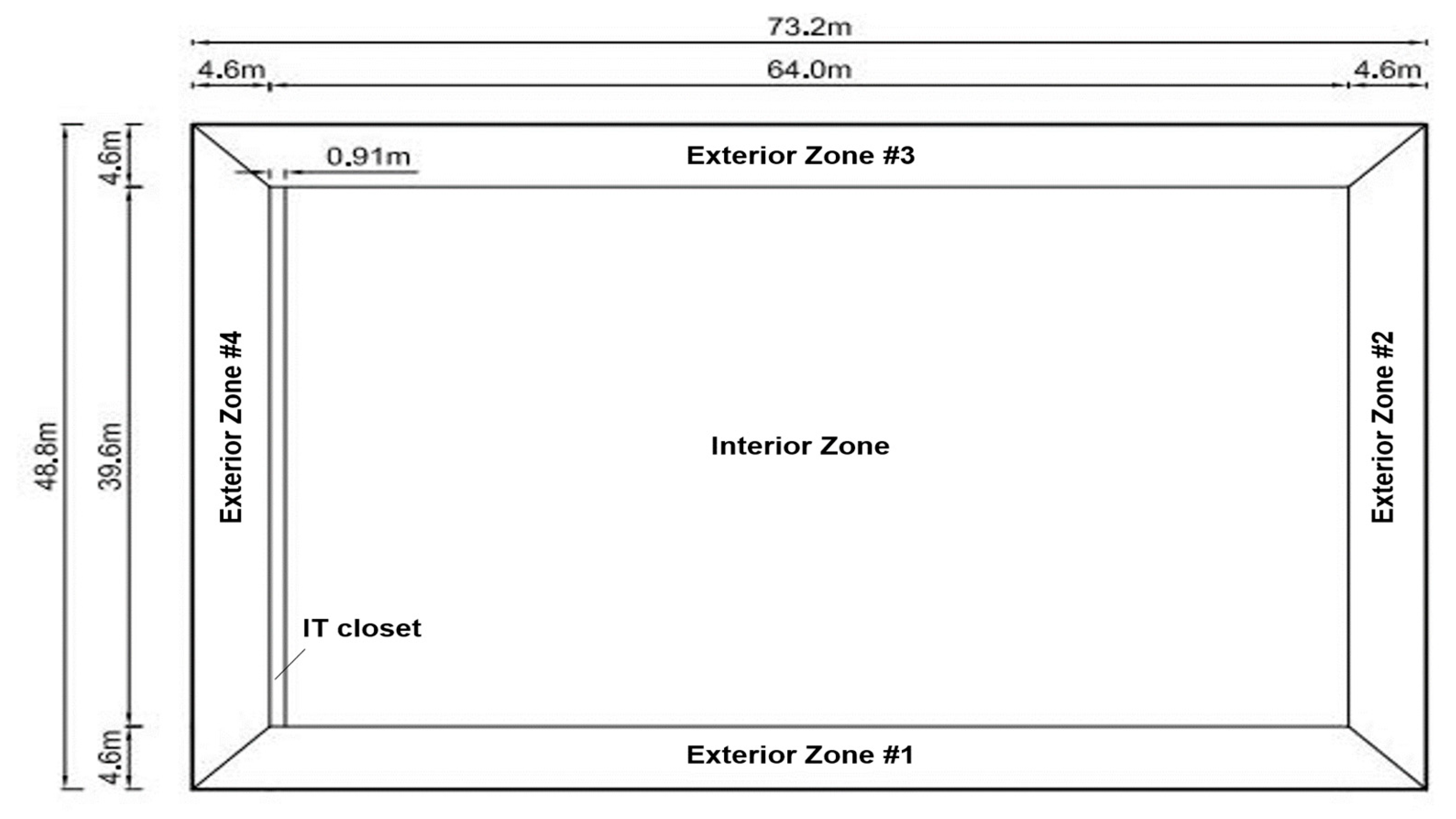
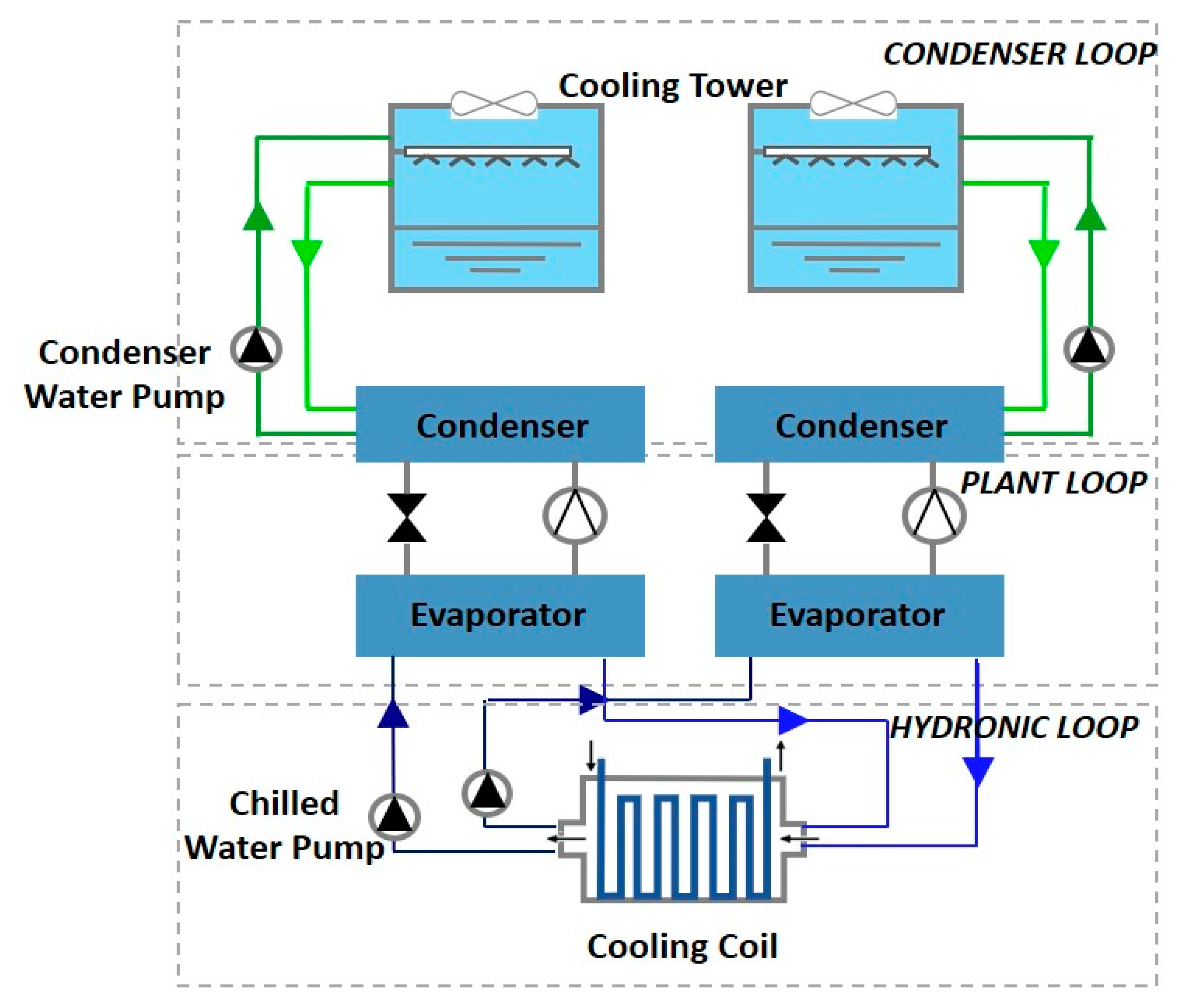
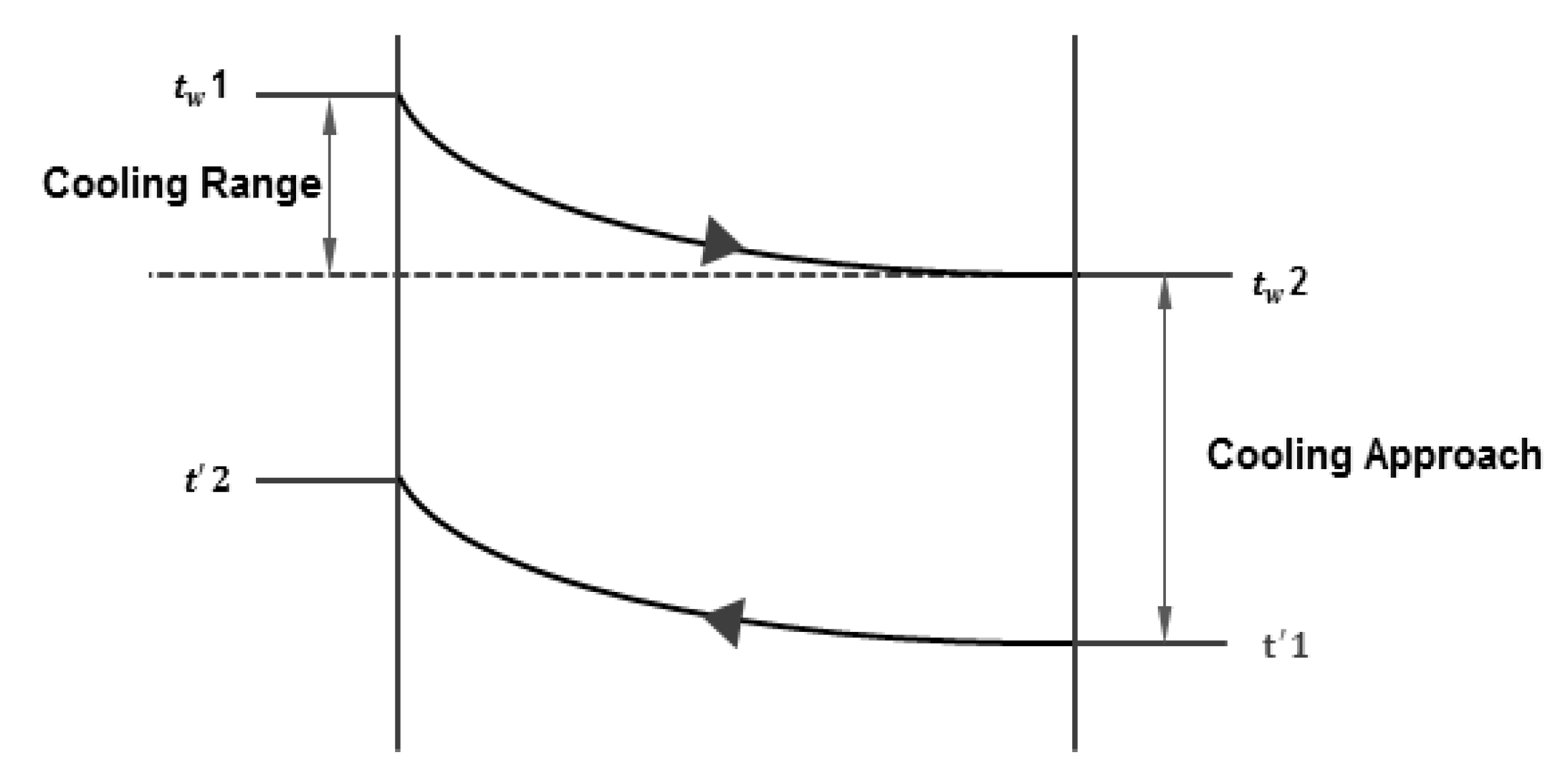
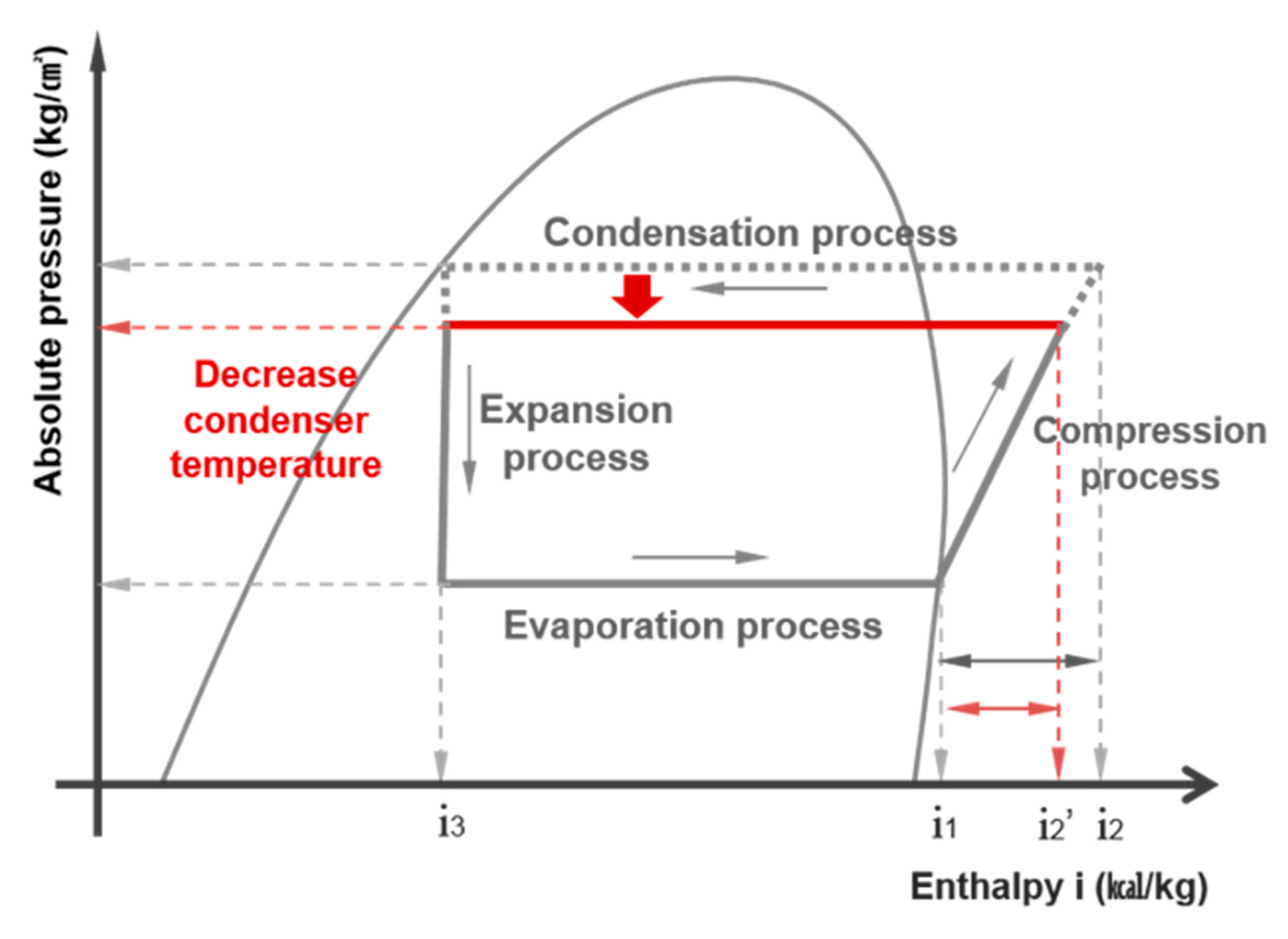
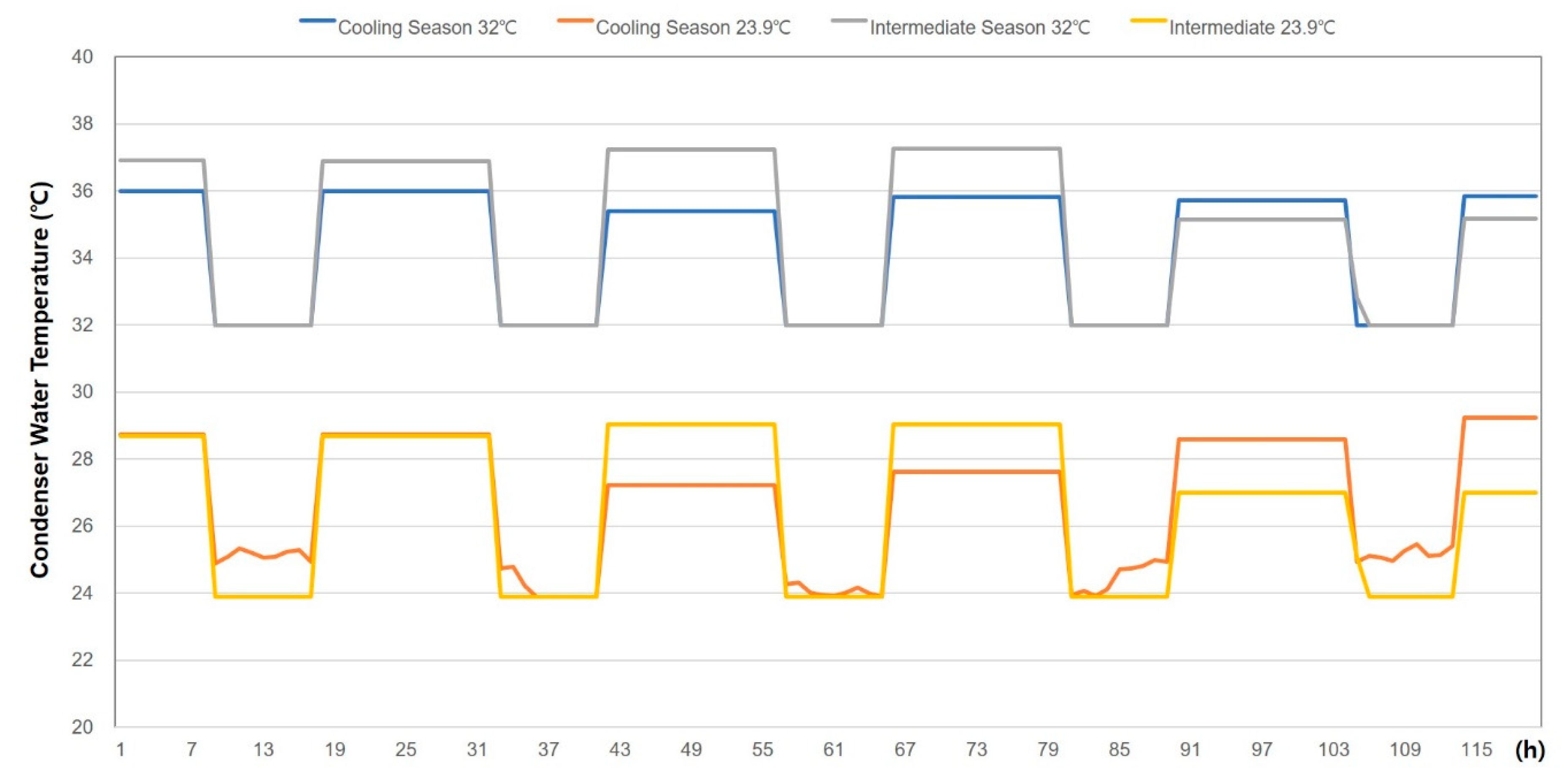
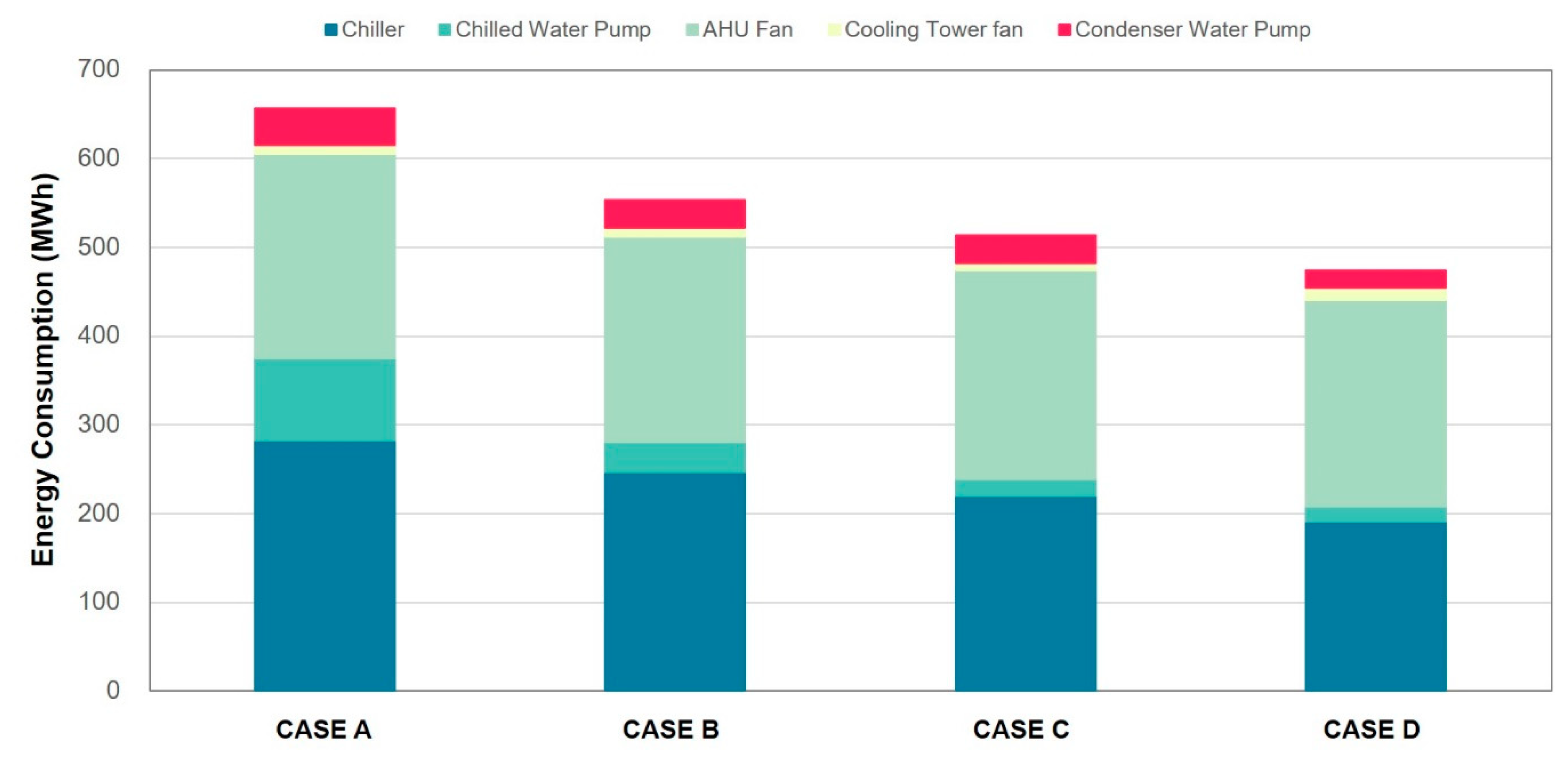
| Month | Outdoor Temperature (°C) | Mean Wet-Bulb Temperature (°C) | Mean Relative Humidity (%) | Solar Radiation (W/m2) | |
|---|---|---|---|---|---|
| High | Low | ||||
| Jan. | 7 | −10.7 | −4.8 | 52.3 | 410.6 |
| Feb. | 12.5 | −9.1 | −1.6 | 54.9 | 448.2 |
| Mar. | 21.4 | −3.3 | 2.3 | 52.2 | 487.2 |
| Apr. | 21.0 | 3.1 | 7.1 | 54.6 | 481.0 |
| May | 28.1 | 8.4 | 12.6 | 58.0 | 559.8 |
| Jun. | 31.9 | 14.8 | 17.8 | 65.8 | 583.6 |
| Jul. | 31.1 | 17.7 | 20.7 | 74.8 | 509.2 |
| Aug. | 33.1 | 18.2 | 22.1 | 74.2 | 518.3 |
| Sep. | 30.8 | 11.2 | 16.8 | 62.6 | 509.5 |
| Oct. | 23.3 | 0.9 | 10.5 | 60.9 | 506.8 |
| Nov. | 19.7 | −1.3 | 4.8 | 57.3 | 417.2 |
| Dec. | 12.8 | −13 | −1.5 | 20.4 | 390.6 |
| Categories | Details | |
|---|---|---|
| Building outlines | Site/Weather location | Seoul, South Korea |
| Use | Office | |
| Floors | B1F to 12F | |
| Operation hour | 09 to 18 h | |
| Floor/Gross Floor area | 3504/46,320 m2 | |
| Window-to-Wall Ratio | 40% | |
| Thermal performance (W/m2·K) | Outer wall/Roof | 0.240/0.150 |
| Door/Window (SHGC) | 1.5/1.5 (0.516) | |
| Room temperature set point (°C) | Cooling | 26 |
| Heating | 20 | |
| AHU discharge temperature (°C) | 12.8 | |
| Classification | Airflow (CMM) | Pressure (Pa) | Power (kW) | Efficiency | Qty |
|---|---|---|---|---|---|
| AHU#1 (CAV) | 14,976 | 1018 | 7.5 | 0.60 | 1 |
| AHU#2 (VAV) | 33,480 | 1389 | 26.9 | 0.61 | 1 |
| AHU#3 (VAV) | 320,760 | 1389 | 287.1 | 0.61 | 1 |
| AHU#4 (VAV) | 36,252 | 1389 | 29.8 | 0.61 | 1 |
| Categories | Details | ||
|---|---|---|---|
| Centrifugal Chiller | Capacity/COP | 1286 kW/6.28 | |
| Chilled Water | Inlet/outlet temp. (°C) | 12/7 | |
| Water flow (LPM) | 5034 | ||
| Condenser Water | Inlet/outlet temp. (°C) | 32/37 | |
| Water flow (LPM) | 8490 | ||
| Cross Flow Cooling Tower | Capacity | 1571 kW | |
| Condenser Water | Inlet/outlet temp. (°C) | 37/32 | |
| Water Flow (LPM) | 8490 | ||
| Fan | Fan power (kW) | 18.5 | |
| Air Flow (CMM) | 2959 | ||
| Chilled Water Pump | Head (kPa)/Water flow (LPM) | 179/5046 | |
| Power (kW)/Motor efficiency | 21.5/0.9 | ||
| Condenser Water Pump | Head (kPa)/Water flow (LPM) | 149/8490 | |
| Power (kW)/Motor efficiency | 30/0.9 | ||
| Categories | Pump Configuration | Head (kPa) | Water Flow (LPM) | Power (kW) | Motor Efficiency | Qty |
|---|---|---|---|---|---|---|
| Case 1 | Primary (Constant Speed) | 1793 | 5010 | 21.3 | 0.9 | 2 |
| Case 2 | Primary (Variable Speed) | 1793 | 5010 | 21.3 | 0.9 | 2 |
| Case 3 | Primary (Constant) | 44.7 | 5010 | 5.3 | 0.9 | 2 |
| Secondary (Variable) | 1342 | 10,014 | 31.9 | 0.9 | 1 |
| Categories | Chiller | Chilled Water Pump | AHU Fan | Cooling Tower Fan | Condenser Water Pump | Sum | Cut-Off Rate (%) |
|---|---|---|---|---|---|---|---|
| Cooling season (Aug. 7 to 13) | |||||||
| Case 1 | 14,672 | 2151 | 3215 | 792 | 1347 | 22,178 | - |
| Case 2 | 13,251 | 1817 | 3303 | 651 | 1348 | 20,370 | 8.1 |
| Case 3 | 14,914 | 1526 | 3236 | 810 | 1348 | 21,833 | 1.6 |
| Intermediate season (May. 1 to 7) | |||||||
| Case 1 | 6885 | 1519 | 2659 | 173 | 883 | 12,119 | - |
| Case 2 | 6083 | 775 | 2660 | 216 | 722 | 10,455 | 13.7 |
| Case 3 | 7145 | 1125 | 2670 | 149 | 993 | 12,082 | 0.3 |
| Chilled Water Leaving Temp. (∆T) | Chiller | Chilled Water Pump | AHU Fan | Cooling Tower Fan | Condenser Water Pump | Sum |
|---|---|---|---|---|---|---|
| Cooling season (Aug. 7 to 13) | ||||||
| 5 ℃ (10 K) | 13,840 | 916 | 3675 | 697 | 1348 | 20,476 |
| 6 ℃ (10 K) | 13,282 | 917 | 3616 | 664 | 1348 | 19,826 |
| 7 ℃ (10 K) | 12,722 | 919 | 3430 | 609 | 1348 | 19,027 |
| 8 ℃ (9 K) | 12,385 | 1019 | 3526 | 604 | 1348 | 18,882 |
| 9 ℃ (9 K) | 12,077 | 1021 | 3659 | 590 | 1348 | 18,695 |
| Intermediate season (May. 1 to 7) | ||||||
| 5 ℃ (10 K) | 6254 | 403 | 2688 | 213 | 715 | 10,273 |
| 6 ℃ (10 K) | 6059 | 414 | 2697 | 208 | 711 | 10,087 |
| 7 ℃ (10 K) | 5787 | 423 | 2711 | 203 | 704 | 9828 |
| 8 ℃ (9 K) | 5550 | 420 | 2754 | 200 | 698 | 9622 |
| 9 ℃ (9 K) | 5288 | 460 | 2784 | 193 | 701 | 9425 |
| Categories | Cooling Season (Aug. 7 to 13) | Intermediate Season (May 1 to 7) | ||
|---|---|---|---|---|
| 32 °C | 23.9 °C | 32 °C | 23.9 °C | |
| Chiller | 12,985 | 10,592 | 5487 | 4461 |
| Chilled water pump | 961 | 957 | 448 | 447 |
| AHU fan | 3602 | 3361 | 2790 | 2792 |
| Cooling tower fan | 338 | 1570 | 97 | 108 |
| Condenser water pump | 963 | 964 | 492 | 492 |
| Sum | 18,848 | 17,444 | 9314 | 8300 |
| Cut-off rate (%) | - | 7.5 | - | 10.9 |
| Chiller COP (-) | 6.20 | 7.54 | 5.67 | 7.06 |
| Categories | Characteristics | Case A | Case B | Case C | Case D |
|---|---|---|---|---|---|
| Chilled water pump configuration | Primary (constant) | ○ | |||
| Primary (variable) | ○ | ○ | ○ | ||
| Chilled water leaving temp. (△T) | 7 °C (5 K) | ○ | ○ | ||
| 9 °C (9 K) | ○ | ○ | |||
| Cooling tower control | On/off | ○ | ○ | ○ | |
| Two speed | ○ | ||||
| Condenser water pump | Constant | ○ | ○ | ○ | |
| Variable | ○ | ||||
| Condenser water temp. (△T) | 32 °C (5 K) | ○ | ○ | ○ | |
| 23.9 °C (7 K) | ○ |
© 2020 by the authors. Licensee MDPI, Basel, Switzerland. This article is an open access article distributed under the terms and conditions of the Creative Commons Attribution (CC BY) license (http://creativecommons.org/licenses/by/4.0/).
Share and Cite
Ha, J.-w.; Cho, S.; Kim, H.-y.; Song, Y.-h. Annual Energy Consumption Cut-Off with Cooling System Design Parameter Changes in Large Office Buildings. Energies 2020, 13, 2034. https://doi.org/10.3390/en13082034
Ha J-w, Cho S, Kim H-y, Song Y-h. Annual Energy Consumption Cut-Off with Cooling System Design Parameter Changes in Large Office Buildings. Energies. 2020; 13(8):2034. https://doi.org/10.3390/en13082034
Chicago/Turabian StyleHa, Ju-wan, Soolyeon Cho, Hwan-yong Kim, and Young-hak Song. 2020. "Annual Energy Consumption Cut-Off with Cooling System Design Parameter Changes in Large Office Buildings" Energies 13, no. 8: 2034. https://doi.org/10.3390/en13082034
APA StyleHa, J.-w., Cho, S., Kim, H.-y., & Song, Y.-h. (2020). Annual Energy Consumption Cut-Off with Cooling System Design Parameter Changes in Large Office Buildings. Energies, 13(8), 2034. https://doi.org/10.3390/en13082034





